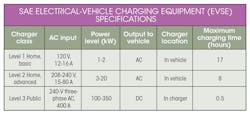Download this article in PDF format.
Almost everyone likes the idea of an electrical vehicle (EV). They’re silent, non-polluting, and have good performance. And there’s no such thing as “gas mileage” to worry about. What’s not to like?
But with sales of just over 1% of the total automotive market, something must be wrong—seriously wrong. And it is. Besides their much higher prices, today’s EVs suffer from limited range and a dearth of charging stations. While our future is probably more EVs and fewer internal-combustion-engine (ICE) vehicles, that future won’t happen until these issues are resolved. Here’s how electronics is making that happen.
Sponsored Resources:
- Maximizing power for Level 3 EV charging stations
- Intelligent battery management and charging for electric vehicles
- Charging ahead toward an EV support infrastructure
Clearing the Path to Ubiquitous EVs
It’s clearly evident that EVs are growing in acceptance throughout the world, but massive adoption has yet to occur. As a percentage of overall vehicle sales, as mentioned, EVs represent slightly more than 1% of sales in the U.S. Thanks to recent efforts by Nissan with its new Leaf, GM’s excellent Bolt, Tesla’s Model 3, plus BMW’s and VW’s models, sales are growing. EVs have significant acceptance problems, but massive efforts are underway to correct that. It just takes time.
These critical factors are being addressed to spur EV growth:
- High prices: This is a major obstacle. But prices will come down over time as sales volume increases and critical components—especially the battery—become less costly.
- Battery costs: The lithium-ion battery has won the EV battery technology battle. But its high price is one of the main reasons why EVs are so expensive. However, considerable battery development continues, and new manufacturing methods are being adopted to solve this problem. Tesla’s forthcoming battery factory in Nevada should soon push Li-Ion prices down to a more affordable level. Developments in China will further improve this solution.
- Vehicle range limitations: Early EVs could not even reach a distance of 100 miles before the battery needed a recharge. While some urban owners can live with minimum range, those who live in the lesser populated rural areas, can’t accommodate such a limitation. The typical ICE vehicle today gets at least 300 to 400 miles per tank. Owners expect that. Newer EV models now boast a range of over 200 miles, finally making these vehicles more attractive. Yet the dearth of charging stations continues to be off-putting to most potential buyers.
- Lack of charging stations: EV owners have their own home chargers, but more public charging stations are needed. The handful that are available are usually busy, but who can wait? Few care to venture out without some knowledge of a nearby charging station. Consumers don’t want that anxiety or the potential inconvenience of “running out of gas.” Today, vehicle owners can readily rely on the tens of thousands of gas stations available. There’s always one nearby. When that number of public chargers comes into being, consumers can venture out on short or long trips and have the confidence that a charging station isn’t far off. Therefore, building out the charging infrastructure becomes a top priority.
- Charging times: It probably takes less than 10 minutes to fill the gas tank of an ICE vehicle. Maybe even less in some cases. Consumers are accustomed to that. On the other hand, charge times for EVs are significant. Home chargers take from 4 to 17 hours for a full recharge, which is acceptable to most. But at a public charging station, consumers don’t want to wait. At best, the time for a full charge is probably a half hour or more, which is unacceptable. In today’s world of instant gratification, impatience, and shortened attention span, long charging times may be the hardest obstacle to overcome.
- Implications for the electric grid: A highly expanded EV charging system will add a significant burden on the existing electrical grid. The good news is that the expansion of new charging stations will be gradual and be spread across the country, giving utilities time to accommodate the extra load. In addition, the increasing adoption of alternative-energy sources like wind and solar will provide additional capacity as needed.
The bottom line is that there’s a clear need for more and faster battery-charging stations. The effectiveness of an extended charging infrastructure depends on the electronics solutions put forth to meet these demands.
Charger Technology
The Society of Automotive Engineers (SAE) currently defines three classes or levels of vehicle charging (see table).
Level 1 and 2 chargers are built into the vehicle itself. Standard single- or two-phase home ac provides the power. Charging times are lengthy but livable, with overnight charging scenarios being the most common.
Level 3 chargers are defined primarily for public charging stations. With three-phase power input, significantly faster charging times are possible. Level 3 chargers output dc to charge the batteries directly. With an output in the 200- to 800-V range and current levels up to 400 A or so, charging time is drastically reduced.
Intelligent Battery Management and Charging
Successful EVs must have fast, efficient, and safe battery charging. Level 1 and 2 chargers reside inside the vehicle. That implies a proper battery-management and charging system. Lithium-ion batteries are fussy and needy. If they’re not properly designed, handled, and charged, they can fail, even catch fire or explode. Successful charging occurs when good battery monitoring and control is deployed.
EV batteries typically are built with modules that are then connected in series and parallel to achieve the voltage and current rating needed to drive the vehicle. These modules and the final battery unit use battery-monitoring ICs (BMICs) to continuously observe the voltage on each cell in every module. Even small variations in cell voltage could signal oncoming danger in the form of an explosion or fire. Temperature measurement provides additional data to assess the charging status.
The information from each module BMIC is transmitted serially, consolidated, and delivered to a battery cell-management controller (CMC). The CMCs then send data to a battery-management controller (BMC) and its microcontroller (MCU). The BMC uses all of this data to make decisions about charging rate or power usage to prevent damage or to shorten battery life. Powerful MCUs are needed to manage these functions.
Charging Station Electronics
An example of a public Level 3 charging station is illustrated in Figure 1. The three-phase 240 V ac is applied to an ac-dc power supply that includes power factor correction (PFC). The output is a high dc voltage in the 400 V range. This is applied to a dc-dc converter that translates the dc into the correct value of dc required of the battery, usually in the 300- to 800-V range. This voltage is connected to the vehicle with a standardized plug.
1. Shown is a general block diagram of an SAE Level 3 charger.
Besides the dc connection, the plug also establishes a data path with the vehicle via a controller area network (CAN) port. The data includes battery type and other specifications to ensure the correct charging profile for the specific battery used.
Other system components are a human-machine interface (HMI), protection circuits, and a battery-management system (BMS). The HMI is usually an LCD display with touchscreen capability that provides communications with the customer who is charging. Payment capability is included, not unlike that now on gas pumps.
The power supplies, which are of the switch-mode type, develop high voltage. As a result, they’re usually made with silicon MOSFETs or IGBTs. Some newer systems may use wide-bandgap devices like SiC MOSFETs.
The Power Stages
There are multiple options for implementing the ac-dc supply, PFC, and dc-dc converter. The goal is maximum efficiency. One of the best combinations is a Vienna rectifier PFC-corrected supply followed by a full-bridge dc-dc converter using MOSFETs (Fig. 2).
2. In a typical Level 3 charger, there’s a Vienna rectifier with PFC (left) and a pair of DC-DC converters that generate the charging voltage (right). MOSFETs are driven by PWM outputs from the MCUs.
The Vienna rectifier is a circuit that performs the three-phase ac-dc conversion, but also implements PFC and regulation. It uses diode half-bridges and MOSFETs driven by PWM signals to charge the output capacitors. The input inductors, diodes, and capacitors act as a boost converter. Subsequently, a high dc voltage is developed. MOSFET switching rate is in the 20-kHz range. PWM signals are created in the accompanying microcontroller (not shown).
Following the Vienna rectifier are two parallel resonant dc-dc converters that develop the output voltage charging the battery. The related MOSFETs are driven by a microcontroller. Overall system efficiency is in the range of 98%.
Computing Power
Like all electronic systems today, the Level 3 charger is managed by one or more MCUs. Given the complexity of the Vienna rectifier and dc-dc converter, the MCUs controlling them must be unusually powerful. Fast multicore devices with DSP are common. The HMI also needs good computing power to handle payment transactions.
Communications
The essential communications link is the CAN connection on the charger plug-in connector. It’s absolutely necessary that the battery profile details are communicated to the charger so that it can properly deliver and control the charge, without damage, in the least amount of time. One possible future revision to the Level 3 standard may be to replace the CAN interface with a wireless link. Multiple possibilities exist, such as Bluetooth LE, Zigbee, and sub-1 GHz ISM radios. Even the short-range near-field communications (NFC) could be used. Then there’s the HMI communications with external services for payment transactions.
Summarizing
Although EVs have been available for some time now, their limitations and the absence of a full-blown support infrastructure have discouraged many potential users. The main requirement for mass adoption of electric vehicles is a huge expansion of the charging infrastructure. The technology that goes into a charging station must be efficient and cost-effective, as well as provide an overall positive customer experience.
As the popularity of electric vehicles grows, power designers will be challenged to provide systems that can adapt to a wide variety of batteries and vehicles with vastly diverse performance requirements. Partnering with a semiconductor company that can provide parts and design assistance is recommended. In the meantime, the following links provide details and examine the key considerations that are best suited to meeting the challenges of including battery performance, lifespan and, of course, safety while designing intelligent battery management and charging systems.
Sponsored Resources:



